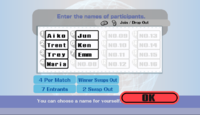| Welcome to SmashWiki! Log in or create an account and join the community, and don't forget to read this first! |
| Notices |
|---|
| SmashWiki will be experiencing a server migration on April 16th, 2025, expected to begin at 7:00 am (EDT) and lasting for up to 12 hours. The wiki may be entirely unavailable during that time. |
Rotation: Difference between revisions
(I was going to undo the edits, then I learnt this page sucked, so I fixed it.) |
Queen Junko (talk | contribs) (There was some wrong information here, so I tried to fix it. I wonder if anyone actually used Rotation... today was the first time I tried it out...) |
||
| Line 1: | Line 1: | ||
{{ArticleIcons|ssbb=y}} | {{ArticleIcons|ssbb=y}} | ||
[[File: | [[File:Rotation.png|right|thumb|Selecting players for a Rotation.]] | ||
'''Rotation''' is a [[Versus mode]] | '''Rotation''' is a [[Versus mode]] in ''[[Super Smash Bros. Brawl]]'' that assists players in rotating players into and out of group brawls if there are more than four players. | ||
A mode similar to Rotation existed in ''[[Super Smash Bros. Melee]]'' as part of | In Rotation, players are first asked how many people will be taking part in each brawl. Then, they are asked how many people they want to swap out after each game, as well as whether to swap out the winners or the losers of the match, which can be changed at any time after the Rotation begins. The [[rule]]s of the brawl are then set up, and then, players can register using [[name]]s to identify one another. | ||
During the Rotation, active players confirm their placement in the brawl, starting with the first player, though they also have the option of giving up their spot to the next person in the queue. After confirming their placement, the match starts, and after the match concludes, the players, as determined by the initial Rotation setup, swap places where required. | |||
Up to 16 players can be included in a Rotation. It requires at least 3 players. | |||
A mode similar to Rotation existed in ''[[Super Smash Bros. Melee]]'', as part of the [[Tournament Mode (SSBM)|Tournament Mode]]. Players could set up Winner Out and Loser Out tournaments, though this interface was less streamlined and in-depth as ''Brawl's'' system. | |||
{{SSBBMenus}} | {{SSBBMenus}} | ||
Revision as of 21:41, June 24, 2017
Rotation is a Versus mode in Super Smash Bros. Brawl that assists players in rotating players into and out of group brawls if there are more than four players.
In Rotation, players are first asked how many people will be taking part in each brawl. Then, they are asked how many people they want to swap out after each game, as well as whether to swap out the winners or the losers of the match, which can be changed at any time after the Rotation begins. The rules of the brawl are then set up, and then, players can register using names to identify one another.
During the Rotation, active players confirm their placement in the brawl, starting with the first player, though they also have the option of giving up their spot to the next person in the queue. After confirming their placement, the match starts, and after the match concludes, the players, as determined by the initial Rotation setup, swap places where required.
Up to 16 players can be included in a Rotation. It requires at least 3 players.
A mode similar to Rotation existed in Super Smash Bros. Melee, as part of the Tournament Mode. Players could set up Winner Out and Loser Out tournaments, though this interface was less streamlined and in-depth as Brawl's system.
| hide Super Smash Bros. Brawl menu items | |
|---|---|
| Group | Brawl (Time · Stock · Coin Battle · Team Battle) · Rules · Special Brawl · Rotation · Tourney · Names |
| Solo | Classic · All-Star · Adventure Mode: The Subspace Emissary · Events · Stadium (Target Smash!! · Home-Run Contest · Multi-Man Brawl · Boss Battles) · Training |
| Wi-Fi | Spectator Mode · With Anyone · With Friends |
| Vault | Trophies & Stickers (Trophy Gallery · Trophy Hoard · Coin Launcher · Sticker Album · Sticker Center) · Stage Builder · Album · Challenges · Replays · Masterpieces · Chronicle |
| Options | Screen · Deflicker · Rumble · Controls · Sound · My Music · Erase Data |
| Data | Movies · Records (Group Records · Brawl Records · Notices) · Sound Test |

